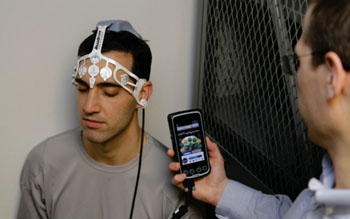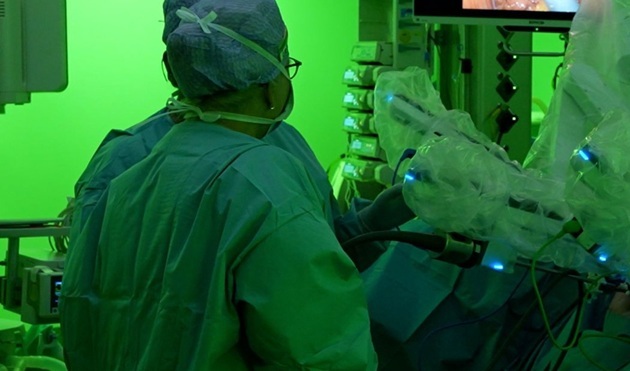Rapid Response Device Assesses Head Trauma Patients
|
By HospiMedica International staff writers Posted on 09 Dec 2014 |

Image: The BrainScope Ahead 100 system (Photo courtesy of Brainscope).
A noninvasive, handheld system uses an in situ electroencephalograph (EEG) to provide an interpretation of the structural condition of the patient’s brain after head injury.
The BrainScope Ahead 100 utilizes product miniaturization and advanced signal processing methods to provide an objective assessment and categorization of brain electrical activity associated with brain injury, identifying patterns consistent with a traumatically induced structural brain injury and clinical manifestations of functional traumatic brain injury (TBI). It is indicated for use as an adjunct to standard clinical practice for evaluation of patients who sustained a closed head injury within 24 hours, between the ages of 18–80 years, and who are being considered for a head computerized tomography (CT) scan.
The system consists of three main components: a hand-held device that includes software and algorithms for EEG acquisition, analysis, and patient stratification; a disposable electrode headset; and a web-based capability for centralized storage and review of patient data. The application of advanced mathematics and miniaturized hardware is designed to bridge the limitations of traditional EEG and provide tools for an initial assessment and adjunctive assessment across the brain care path. The Ahead 100 is a product of BrainScope (Bethesda, MD, USA), and has been approved by the US Food and Drug Administration (FDA).
“Over the last two years, we have focused on improving this technology, including adapting it for use on ubiquitous hardware platforms such as smartphones and tablets, and by benefitting from machine learning and proprietary algorithm classification techniques from increased data derived from our numerous clinical studies,” said Michael Singer, president and CEO of BrainScope. “We will direct all of our commercialization efforts for the Ahead product family using these hardware platforms both for assessment of structural brain injury in urgent care settings, and for assessment of concussion on the battlefield and the sports field.”
“Using sophisticated classification algorithm methods we sought neurophysiological profiles or signatures of changes in brain electrical activity associated with traumatic structural brain injury,” said Leslie Prichep, MD, director of the quantitative neurophysiological brain research lab at the NYU School of Medicine (NY, USA), and consultant to BrainScope. “One of the most important findings was the extremely high performance of the Ahead 100 to identify the absence of structural brain injury after a patient has sustained a head injury. This provides important information to the clinician, contributing to a rule-out for one of the most prevalent concerns clinicians have with mildly presenting patients.”
Head injury is the leading cause of death and disability in people under 45 years of age in developed countries, mostly resulting from falls and road accidents. The primary injury is caused by an initial mechanical force, followed by a secondary injury which develops in the hours and days afterwards, which is largely responsible for patients' mental and physical disabilities.
Related Links:
BrainScope
The BrainScope Ahead 100 utilizes product miniaturization and advanced signal processing methods to provide an objective assessment and categorization of brain electrical activity associated with brain injury, identifying patterns consistent with a traumatically induced structural brain injury and clinical manifestations of functional traumatic brain injury (TBI). It is indicated for use as an adjunct to standard clinical practice for evaluation of patients who sustained a closed head injury within 24 hours, between the ages of 18–80 years, and who are being considered for a head computerized tomography (CT) scan.
The system consists of three main components: a hand-held device that includes software and algorithms for EEG acquisition, analysis, and patient stratification; a disposable electrode headset; and a web-based capability for centralized storage and review of patient data. The application of advanced mathematics and miniaturized hardware is designed to bridge the limitations of traditional EEG and provide tools for an initial assessment and adjunctive assessment across the brain care path. The Ahead 100 is a product of BrainScope (Bethesda, MD, USA), and has been approved by the US Food and Drug Administration (FDA).
“Over the last two years, we have focused on improving this technology, including adapting it for use on ubiquitous hardware platforms such as smartphones and tablets, and by benefitting from machine learning and proprietary algorithm classification techniques from increased data derived from our numerous clinical studies,” said Michael Singer, president and CEO of BrainScope. “We will direct all of our commercialization efforts for the Ahead product family using these hardware platforms both for assessment of structural brain injury in urgent care settings, and for assessment of concussion on the battlefield and the sports field.”
“Using sophisticated classification algorithm methods we sought neurophysiological profiles or signatures of changes in brain electrical activity associated with traumatic structural brain injury,” said Leslie Prichep, MD, director of the quantitative neurophysiological brain research lab at the NYU School of Medicine (NY, USA), and consultant to BrainScope. “One of the most important findings was the extremely high performance of the Ahead 100 to identify the absence of structural brain injury after a patient has sustained a head injury. This provides important information to the clinician, contributing to a rule-out for one of the most prevalent concerns clinicians have with mildly presenting patients.”
Head injury is the leading cause of death and disability in people under 45 years of age in developed countries, mostly resulting from falls and road accidents. The primary injury is caused by an initial mechanical force, followed by a secondary injury which develops in the hours and days afterwards, which is largely responsible for patients' mental and physical disabilities.
Related Links:
BrainScope
Latest Critical Care News
- Breathable Electronic Skin Paves Way for Next-Generation Wearable Devices
- AI Transforming Colon Cancer Diagnosis
- Ventricular Assist Device Offers Long-Term Use in Children Waiting for Donor Heart
- Precision Approach Improves Immunotherapy Effectiveness for ICU Patients with Sepsis
- Soft Robots Could Donate Their Heart to Humans
- Bioadhesive Strategy Prevents Fibrosis Around Device Implants on Peripheral Nerves
- Miniature Non-Invasive Robotic Catheters to Improve Infertility Treatments
- Stick-On Patch Monitors Baby's Movements In Utero
- EEG-Based AI Technology Accurately Diagnoses Alzheimer’s and Dementia
- Robot Lymphatic System Paves Way for Self-Powered Wearables and Machines
- Focused Ultrasound Technique Successfully Treats Pediatric Brain Cancer
- Nasal Drops Fight Brain Tumors Noninvasively
- AI Helps Optimize Therapy Selection and Dosing for Septic Shock
- Glowing Bacteria ‘Pills’ for Detecting Gut Diseases Could Eliminate Colonoscopies
- Skin-Permeable Polymer Patch Delivers Insulin Non-Invasively Through Skin
- Nanogel Technology Almost 100% Effective in Destroying Drug-Resistant Bacteria Within Hours
Channels
Surgical Techniques
view channel
Minimally Invasive Surgery Proven Safe and Effective for Complex ‘Whipple’ Procedure
Tumors of the pancreatic head often require a highly complex operation known as pancreatoduodenectomy or the Whipple procedure. This surgery involves removing multiple structures and creating several internal... Read more
Catheter-Based Procedures Offer Less Invasive Option for Treatment of Valvular Disease
Valvular heart disease, caused by tight or leaky valves between heart chambers, affects up to 10% of older adults and leads to more than 120,000 deaths globally each year. Traditional open-heart surgery... Read morePatient Care
view channel
Revolutionary Automatic IV-Line Flushing Device to Enhance Infusion Care
More than 80% of in-hospital patients receive intravenous (IV) therapy. Every dose of IV medicine delivered in a small volume (<250 mL) infusion bag should be followed by subsequent flushing to ensure... Read more
VR Training Tool Combats Contamination of Portable Medical Equipment
Healthcare-associated infections (HAIs) impact one in every 31 patients, cause nearly 100,000 deaths each year, and cost USD 28.4 billion in direct medical expenses. Notably, up to 75% of these infections... Read more
Portable Biosensor Platform to Reduce Hospital-Acquired Infections
Approximately 4 million patients in the European Union acquire healthcare-associated infections (HAIs) or nosocomial infections each year, with around 37,000 deaths directly resulting from these infections,... Read moreFirst-Of-Its-Kind Portable Germicidal Light Technology Disinfects High-Touch Clinical Surfaces in Seconds
Reducing healthcare-acquired infections (HAIs) remains a pressing issue within global healthcare systems. In the United States alone, 1.7 million patients contract HAIs annually, leading to approximately... Read moreHealth IT
view channel
EMR-Based Tool Predicts Graft Failure After Kidney Transplant
Kidney transplantation offers patients with end-stage kidney disease longer survival and better quality of life than dialysis, yet graft failure remains a major challenge. Although a successful transplant... Read more
Printable Molecule-Selective Nanoparticles Enable Mass Production of Wearable Biosensors
The future of medicine is likely to focus on the personalization of healthcare—understanding exactly what an individual requires and delivering the appropriate combination of nutrients, metabolites, and... Read moreBusiness
view channel
Philips and Masimo Partner to Advance Patient Monitoring Measurement Technologies
Royal Philips (Amsterdam, Netherlands) and Masimo (Irvine, California, USA) have renewed their multi-year strategic collaboration, combining Philips’ expertise in patient monitoring with Masimo’s noninvasive... Read more
B. Braun Acquires Digital Microsurgery Company True Digital Surgery
The high-end microsurgery market in neurosurgery, spine, and ENT is undergoing a significant transformation. Traditional analog microscopes are giving way to digital exoscopes, which provide improved visualization,... Read more
CMEF 2025 to Promote Holistic and High-Quality Development of Medical and Health Industry
The 92nd China International Medical Equipment Fair (CMEF 2025) Autumn Exhibition is scheduled to be held from September 26 to 29 at the China Import and Export Fair Complex (Canton Fair Complex) in Guangzhou.... Read more












